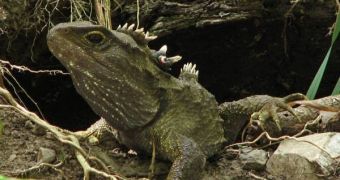Wildlife experts in New Zealand were thrilled to discover a hatchling baby tuatara in the New Zealand forests this week, officials announced on Thursday. The reptiles are highly endangered and extremely rare, and individuals haven't observed them in the wild for more than 200 years. Needless to say, everyone at the Karori Wildlife Sanctuary is thrilled about the discovery, which comes a short while after the world learned that a captive tuatara had fathered its first offspring at the age of 111.
Employees conducting routine maintenance in the sanctuary, located near the capital city of Wellington, stumbled upon the ancient lizard by accident, and couldn't believe their eyes at first. The animal has a direct lineage that can be tracked down to the age of the dinosaurs, which has earned it the classification of a “living fossil.” Indeed, one quick look at the reptile tells you that this is not your average lizard.
“We are all absolutely thrilled with this discovery. It means we have successfully re-established a breeding population back on the mainland, which is a massive breakthrough for New Zealand conservation,” Karori Wildlife Sanctuary conservation manager Raewyn Empson said. According to current estimates, there are in the vicinity of 50,000 of these reptiles living in the wild, on a handful of offshore islands that have been cleared of all the small creature's natural predators. Despite the fact that they reach about 80 centimeters in length when they are fully grown, tuataras are very peaceful animals, which live for one or two centuries, if left alone.
However, the future of the hatchling is still in doubt. Despite the fact that the natural reserve is protected by a fence, to fend off predators, it will still have to survive its future encounters with adult tuataras, which tend to be a bit cannibalistic with their young ones. Birds of prey are also always on the look out for delicious meals such as this one. “Like all the wildlife living here, he'll just have to take his chances,” Empson explained.
“They've been extinct on the mainland for a long time. You can breed tuatara by eliminating risk, but to have results like this among many natural predators (like native birds) is a positive sign,” Southland Museum and Art Gallery tuatara curator Lindsay Hazley added.

 14 DAY TRIAL //
14 DAY TRIAL //